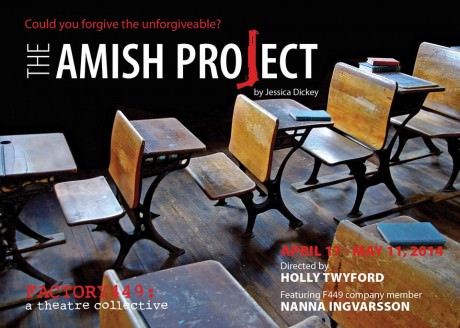Shooting sprees have become commonplace in our media consumption. Nowadays breaking news of yet another gunman and his multiple victims (the shooters are always male) more numbs than shocks. The scattershot slaughters seem to blur together in incremental succession—as though we’ve become inured to this American way of taking life. Now comes Factory 449′s deceptively simple gift The Amish Project. Performed with arrestingly versatile conviction by Nanna Ingvarsson, Jessica Dickey’s one-hander is a dramatic imagining of a 2006 incident in Nickel Mines, PA, when the local milkman entered an Amish schoolhouse with intent to sexually molest the little girls there but instead shot them and then himself. By the end The Amish Project jolts with a transformational viewpoint that is nearly as unthinkable and inconceivable as the crime itself.

According to the playscript, Amish people believe “there is no why.” As depicted in The Amish Project, they do not try to wrap their minds around what the outside world finds inexplicable in such a killer’s savage actions. His motivations do not much matter or even register for this insular community. They don’t distract themselves trying to understand what makes the killer tick. They don’t demonize him and distance themselves (“We are all a few bad days from sicko,” says one). What these religious folks do instead is forgive him unconditionally—a profoundly faith-based collective action that in its own way is also inexplicable.
The play is woven of a rich texture of the stories of several characters, all poignantly portrayed by Ingvarsson. Two of them are little girls, sisters, who were among the five slain in the shooting. Another is the widow of the gunman, a wife unaware of the extent of her husband’s “darkness.” Another is a non-Amish scholar of Amish ways who offers expositional context. Another is the inscrutable gunman himself. I especially enjoyed Ingvarsson’s vibrant portrait of a young Hispanic girl who touchingly figures in the forgiveness story arc. Ingvarsson, though clothed throughout in a typical Amish dress, bonnet, and apron by Costume Designer Scott Hammer, makes us believe each of these people exists onstage in the moment. With the specificity of her characterizations and her swift switching between them, Ingvarsson’s performance is extraordinary to behold.
Set Designer Greg Stevens evokes the fateful school room and situates the storytelling with an exposed-lath wall on which hangs a blackboard where the captivating 14-year-old draws and writes as her childlike patter takes us into the world of the play. Lighting Designer Joseph R. Walls creates one impressive visual environment after another, including the surprising effect of a live TV-studio broadcast. And Sound Designer Kevin O’Connell’s work, which begins with a lovely Amish vocal, acoustically expands the stage dimensions far beyond its actual small space.
Director Holly Twyford has insightfully shaped the pace and amplitude of the entire production, but especially outstanding is the intuitive collaboration she has evidently entered into with Ingvarsson. As with any multiply peopled one-person show, the role is a huge challenge. It requires the solo performer to instantly inhabit diverse characters using only her own instrument. The fact that Twyford herself knows that challenge from the inside is clearly apparent in how Ingvarsson’s engaging exteriorizations are framed.
Factory 449 doesn’t pick easy stuff. The Amish Project has an appealing, at times delightful, surface texture: for instance the 14-year-old’s charming narrative of a prison break told simply with hand gestures and chalk drawings, and the widow’s amusing concern with facial wrinkles and moisturizing sunscreen product. Yet the play also has a profound undercurrent, at times dark and distressing but at times illuminating and joyful. Would you believe a secular play with credible god talk?

There are two double whammys in 449 Factory’s The Amish Project—first the unfathomable massacre committed by the killer, then the baffling benefaction of the believers. The contrast and interplay between those two incomprehensibles will linger in one’s mind and expand it long after.
Running Time: 80 minutes, without intermission.
The Amish Project plays through May 11, 2014 at Factory 449 performing at Anacostia Arts Center – 1231 Good Hope Road, SE, in Washington, DC. Performances are on Thursdays through Saturdays at 8 pm, and Sundays at 3 pm. Tickets can be purchased online. For more information call (202) 355-9449.





